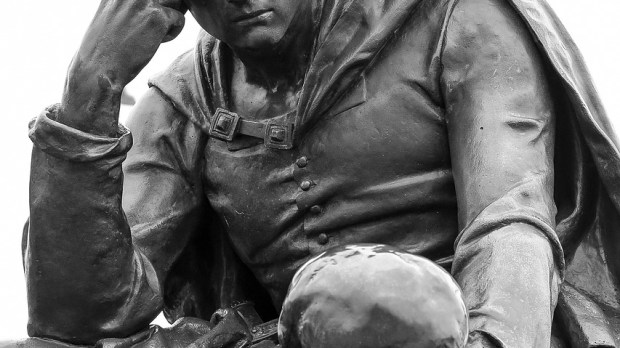You should have seen the look on their faces.
There I was ripping open the Amazon package and pulling out a deep green T shirt. Allowing the shirt to unfold before me, I smiled. My daughters crushed in front of me to catch a glimpse. Prominently emblazoned on the front of the shirt was an over-sized skull donning a coxcomb (jester’s cap) and a simple phrase underneath lamented,
Alas, poor Yorick
My daughters looked at it. And then they looked at me with their foreheads furrowed and that classic single eyebrow raised.
“Poor Yorick?,” they asked.
Ah, yes. A delicious teachable moment…
For anyone unfamiliar, Yorick is the most famous skull in the history of literature. In considering the works of William Shakespeare, many people would conjure up the iconic image of Hamlet pensively gazing down at a grinning skull in his hand as the skull mockingly gazes back. That skull is Yorick.
In Act 5 of Hamlet, the troubled prince has returned to Denmark from England after storming away from his father’s ghost, his mother’s dubious fidelity and his uncle’s treachery. Upon his return, among Hamlet’s first encounters is a curiously cavalier gravedigger (whom Shakespeare calls the clown) singing absently and tossing bones from the grave he is apparently repossessing. Unsettled by this, Hamlet observes to his friend, Horatio,
Has this fellow no feeling of his business, that [he] sings in grave-making?
As skulls and bones are carelessly thrown from the pit, Hamlet recoils and considers who they might have belonged to…a politician? a courtier? a lawyer? Before long, Hamlet engages the digger in a discussion about the nature of his work and how long it takes for the bodies to perish. The digger, offering his considered wisdom on this matter, finds himself expounding on one skull in particular. Asking Hamlet if he knows who the skull belonged to, Hamlet shakes his head. Then the digger tells him,
[Gravedigger]:A pestilence on him for a mad rogue! [He] poured aflagon of [wine] on my head once. This same skull,sir, was Yorick’s skull, the king’s jester.HAMLET: This?[Gravedigger]: E’en that.HAMLET: Let me see. (Takes the skull) Alas, poor Yorick! I knew him, Horatio: a fellow of infinite jest, of most excellent fancy: he hath borne me on his back a thousand times; and now, how abhorred in my imagination it is! my gorge rims at it. Here hung those lips that I have kissed I know not how oft. Where be your gibes now? your gambols? your songs? your flashes of merriment, that were wont to set the table on a roar?
Alas, poor Yorick.
This was Hamlet’s Memento Mori moment. In Laurence Olivier’s 1948 classic film portrayal of Hamlet, the movie opens with the haunting (non-Shakespearean) phrase,
“This is the tragedy of a man who could not make up his mind.”
From the outset of his story, Hamlet is a young man who is confronted with death. The death of a beloved king and father. The death of his love, Ophelia. And in the play’s climax, the death of Ophelia’s brother, his mother, his uncle (and king) and, finally, Hamlet’s own death. When Shakespeare writes tragedy…it is tragic. But it is Hamlet’s poignant moment with Yorick – the jester who played with him as a giggling boy, who gave him attention, who loved him, even – that I found so deeply moving. And in classic Shakespearean fashion, the considered tenderness and humanity so desperately sought after by the young and troubled Hamlet rested not with his regal father, wayward mother or treacherous uncle and king, but with a dead fool. Yorick’s hollowed out sockets, lipless grin, and particularly his body’s ill-treatment by this nameless gravedigging knave nearly made Hamlet ill (“My gorge rims at it”). To what base uses we may return!, Hamlet remarks. “What is it all about? What is life all about?,” Hamlet seems to ask. And Yorick grins.
It is from this moment forward – this bittersweet encounter with Yorick – that Hamlet is awakened and begins to “make up his mind.” Yes, the shock of Ophelia’s death and, of course, the assertive strategy of the young Fortinbras (the Danish kingdom’s young Norwegian enemy) also shook Hamlet to his senses. But I think it was Hamlet’s moment with poor Yorick that made him “remember Death”. Life is meant to be lived. We are called to act. And there is only so much time on earth to right wrongs and live fully. Though Hamlet never shook the oppressive melancholy that enshrouded him, Yorick helped him recall a moment’s tenderness and better understand from where the angst was coming.
Gerard Manley Hopkins once wrote a poem titled Spring and Fall. Dedicated “to a young child”, it speaks to the child in each of us who struggles with the ephemera of life and longs to reclaim that innocence, that permanence, that tenderness that somehow was lost along the way. Poor Yorick reminded Hamlet of this as well – of what once was and has been lost. It is Hamlet’s conflict. And it is ours too.
Márgarét, áre you gríevingOver Goldengrove unleaving?Leáves like the things of man, youWith your fresh thoughts care for, can you?Ah! ás the heart grows olderIt will come to such sights colderBy and by, nor spare a sighThough worlds of wanwood leafmeal lie;And yet you wíll weep and know why.Now no matter, child, the name:Sórrow’s spríngs áre the same.Nor mouth had, no nor mind, expressedWhat heart heard of, ghost guessed:It ís the blight man was born for,It is Margaret you mourn for.
Photo credit: Pixabay

